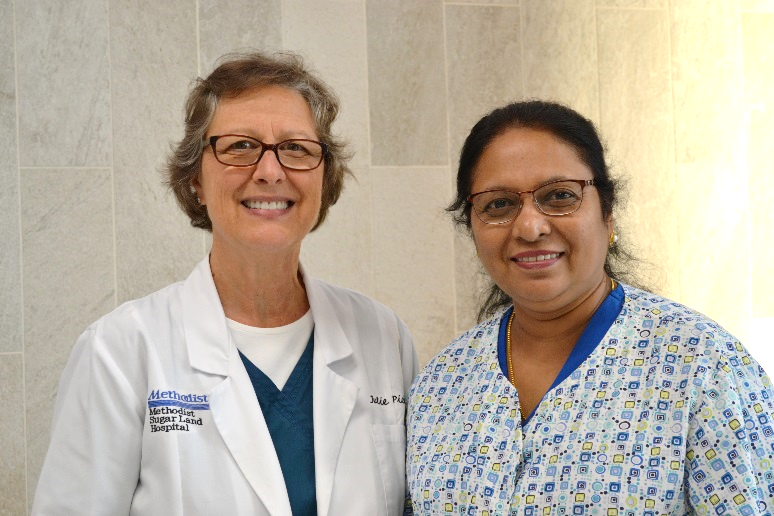HMSL Magnet® Readiness Newsletter, September 2016 • Volume 2, Issue 2
Download printable version.
 What’s in it for me?
What’s in it for me?
Philomena Valson, MSN, CMSRN, RN III, Unit Educator, Interdisciplinary Magnet Champion Co-Chair, Shares Her Thoughts
“The Magnet Recognition program was developed by the American Nurses Credentialing Center (ANCC) based on research conducted by the “American Academy of Nursing” to recognize health care organizations that promote quality outcomes of care in a setting that supports professional practice and dissemination of knowledge and best practices. Organizations like ours invest a lot in time, effort and money trying to achieve the Magnet designation, but, What’s in it for me as a nurse? How can being part of such an organization help me?
I joined 5 East as a clinical nurse in early 2012 with a little under three decades of nursing exposure. I must admit, Houston Methodist Sugar Land is the most patient-centered, technologically advanced, state-of-the-art organization, I have seen yet. A simple reflection is the adherence our organization has to the I CARE values. I witnessed this from day one, through structured preceptorship practices. Everything from tuition reimbursements, free CE through CE Direct, current and up-to-date resources for sharing new knowledge, innovations and best practices.
One month into the team, I became part of the policy and practice council, which I co-chair today. This council is one of the many shared governance councils that promotes structural empowerment within the organization. Being part of councils at the unit, hospital and system level provided me with a platform to voice my opinions.
During the last four years, I also got to witness and be part of the roll out of many new initiatives bolstering our exemplary professional practices through regular discharge education, medication teaching, patient/family education through admission, discharge callbacks, hourly rounds, no pass zone, Visilert, focus of the day, fall prevention, project CE Direct, assistance with certifications and career ladder. At present, we have also started multiple initiatives to reduce C. diff infection rates.
Once I completed my MSN education, I was offered a position as a discharge education nurse. This was part of my transformational leadership experience.This role opened up the opportunity to give back to Houston Methodist through preceptor workshops focusing on best practices and knowledge to experienced nurses with monthly workshops for a period of two years. In addition, I support the Magnet initiatives as a Magnet Champion and currently serve as Co-chair on the Magnet council.
Being a discharge education nurse and unit educator gives me the unique opportunity to interact both with patients and their families as well as with our staff. Additionally, being a part of the shared governance councils allows me to see and track the causal links between our initiatives and our patients’ satisfaction. It also allows me to access and monitor various eempirical outcomes such as zero falls, CLABI, CAUTI, superior HCAHPS, lower readmissions, RTDC and quicker and efficient transition of care.
These are the various aspects of the Magnet model. I like to think of it as the way Houston Methodist Sugar Land operates. Achieving Magnet recognition is just a means to confirm that we are headed in the right direction as an organization. It means that my actions at the bedside matter and that I am a part of a caring team that aims for excellence and excels at it.”
Bringing Magnet to Your Unit
Bringing Magnet to a Small Unit
By Liberty Ramas, BSN, RN, CMSRN
Liberty Ramas, BSN, RN, CMSRN, transferred to the Wound Care Program from a medical/surgical unit where she was regularly educated about Magnet concepts and HMSL’s Journey to Magnet designation. When Liberty transferred to her new unit, she realized that outpatient units sometimes feel alienated or get less exposure to Magnet activities and education than inpatient units.
Liberty discussed the importance of Magnet with her manager, Amber Jones, MSN, RN, and received support to become the Wound Care Program Magnet champion. Liberty’s goal was to bring Magnet education to her unit and share the Wound Care Program’s accomplishments and activities with the rest of the hospital. Liberty is currently a Magnet champion and a member of the Magnet Champion Steering Committee.
With experience under her belt and a passion for making Magnet a reality to all nurses, Liberty offers the following tips for incorporating Magnet to your unit, no matter the size or discipline:
- Be sure that your unit has a Magnet champion! This is the best way to share information and ideas with the unit. Champions, bring back meeting content and apply it to what is going on in the unit.
- Take advantage of leadership support. Don’t be afraid to ask questions or bring new ideas to your manager or director.
- Bring best practices and performance improvement to your unit through performance improvement projects. HMSL uses the Plan-Do-Check-Act performance improvement methodology. Be open to trialing ideas. When something isn’t working, revisit it and brainstorm solutions. Identify ways to implement evidence-based practice in your performance improvement projects.
- Schedule monthly meetings and frequent huddles where Magnet concepts are discussed.
- Introduce activities and ideas implemented in inpatients to the outpatient units. Many concepts can be adapted for outpatient use (i.e. AIDET, teach back). Build relationships with inpatient colleagues and share ideas.
- Ensure that patients are getting The Houston Methodist Experience and that I CARE values are honored by all staff.
- Hardwire shared governance on your unit so that everyone has a voice in how they implement patient and family centered care.
- Be sure that colleagues are aware of educational opportunities, such as CE Direct and tuition reimbursement.
- Be enthusiastic and model behavior for all.
- Be proud of your unit and showcase your unit’s achievements.
- Read your e-mails, reach out to Magnet champion liaisons, and ask questions!
The Wound Care Program experienced challenges due to changes in staffing, but they worked together to keep improving their structures and processes and never let Magnet fall off their radar. Now, the fruits of their labor are evident with increased patient satisfaction and many ongoing process improvement projects. Liberty cannot wait to celebrate when HMSL achieves Magnet recognition!
Best Practice in the Emergency Department
ED Blood Culture Contamination Rate Knockdown
Presented by Karen Cothran RN, CEN
Background: Blood cultures are the “Gold Standard” in diagnosis and treatment of bacteremia. Blood culture contamination causes unnecessary antibiotic administration, and additional tests to identify the reason for the positive blood culture leading to increased hospital length of stay and cost. Blood culture contamination is a common and preventable problem in the Emergency Department (ED).
Objective: Decrease the incidence of contaminated blood cultures in the ED (blood culture contamination rate).
• Benchmark= <3%
• ED Baseline= 7.3%
Design & Setting
• Team: 3 ED RN’s, 1 Unit Educator, ED Management Team
• 27-bed emergency department in a community-based hospital
Methods
• A brief survey was conducted on staff knowledge for blood culture policy and procedure.
• Of 46 responses, 31% lacked knowledge of the policy/procedure.
• Lack of compliance with the hospital approved procedure was observed.
• All staff were re-educated, and we implemented education reinforcement at staff meetings and shift huddles.
• ED staff members’ names were posted along with monthly contamination rates.
• Additionally implemented use of 3ml Chlorhexidine prep, rather than the 1.4ml prep previously used, and utilized a checklist guideline to remind staff of correct steps.
Results: The ED blood culture contamination rate has steadily declined with the implementation of the campaign interventions. Down from 7.3% before campaign inception in April 2014, to a Hospital-wide rate of <3% in May of 2015.
Important Dates
- September 28: Interprofessional Magnet Fair
- November 17: Magnet Thanks & Giving Event (partnering with the EAC)
- February 1, 2017: Magnet Document Submission
 A message from Janet Leatherwood, CNO
A message from Janet Leatherwood, CNO
As we continue on the Journey to Magnet Excellence, I want to stop and reflect on the goals and guiding principles of the American Nurses Credentialing Center’s Magnet Recognition Program. These goals are for nursing and every other professional here at HMSL.
- Promote quality in a setting that supports professional practice
- Identify excellence in the delivery of nursing and interprofessional services to patients
- Disseminate best practices in nursing and interprofessional services
One way we disseminate best practices is through internal and external professional conferences. Our best practices are the evidence of the outcomes of our interventions. Outcomes are defined as quantitative and qualitative evidence related to the impact of structure and process on the patient, nursing workforce, the organization and the consumer/community. Our care must be safe, ethical, autonomous and evidence-based with a focus on quality improvement.
